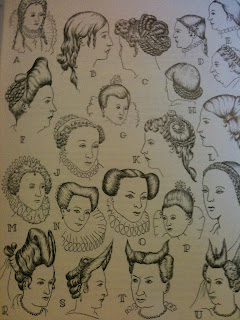Elizabethan Plaits and twists with ribbon.
Below is an Elizabethan portrait of a young girl. Looking at the portrait you can see the persons hair has been tightly plaited at the hair line and has been twisted or wrapped to the back of her head forming an up do. It sort of looks to me as though the hair has been twisted into a bun. The hair looks as if has been done in a heart shape. There is a clear middle parting down the middle of the hair style (very Elizabethan) The hair has been decorated in pearls and what looks to me like roses. This to me looks as if the woman in the portrait is wealthy due to her adornment in the hair. The plait looks to me as if it has been french plaited due to how close the plait is to the root of the hair. The pearls being wrapped around the plait looks as if it is helping hold the hair up as I do not think that they had hair grips in that era! Her hair looks to me as though it is a medium reddish brown. The person in the portrait defiantly screams aristocracy due to the luxurious hair adornment and her clothing are nothing but pearls and what looks like roses.
| Link:1st-artgallery.com Viewed:13.10.13 Here are some images I found of how they thought Elizabethan plaits were worn due to portraits. As you can see I think that ribbons were for decoration and for practical reasons to hold the hair in place it also added colour and a silky texture. (image) Link:Braidsforbrides Viewed:13.10.13 |
In the Elizabethan era to often adorn and secure the hair the women used ribbon. Ribbons were often used instead of hair grips and hair ties. The hair styles also began to become more imaginative as Elizabeth's fashion often inspired her follower to become more creative with their experience.
Here I created a standard three strand plait. I added blue ribbon by wrapping it around the plait. This is a simple Elizabethan look that many women wore as it looked attractive. I wanted to do something simple as I want to improve on my technical skills with hair as this is my weakness therefore over the weeks I hope to develop my plaiting skills which will hopefully help capture my imagination more.
Here I tried a renaissance look which I saw in a portrait and failed to attempt the style! I had also seen it in the film `Ever After`. So I started by selecting two pieces of hair and twisting them outwards, I then began to plait them adding a bit of hair and twisting it into the strand of hair every time I plaited. I did this on both sides forming two twists. I then wrapped the hair round the head. I did not join the hair together and twist into a bun (which is what I should have done). However I will learn from this mistake!
It sort of looked like a hair band which I liked. I also noticed how the plaited headbands came into trend few years back! However it looked tremendously messy I will work on this and document on my blog.I think in the future I will use the front sections on hair to create a cleaner more accurate Renaissance look before I alter it.
Here I attempted to wrap some ribbon in the hair which looks again pretty messy! I watched a few you tube turtrials http://www.youtube.com/watch?v=8yoj7-GQdDc of which I found helpful! Next time I will have to use a needle to wrap the ribbon around the hair in a neater manner. I understand that this hairstyle was popular in Italy in the Elizabethan era more so than England.







.JPG)

.JPG)


.JPG)
.jpeg)








